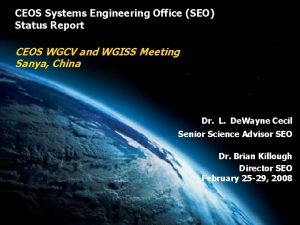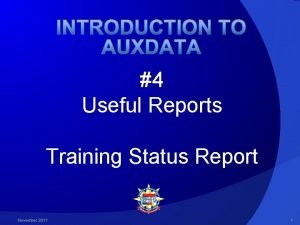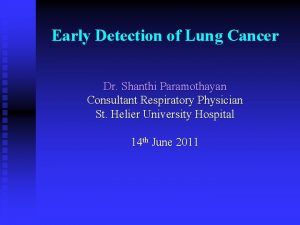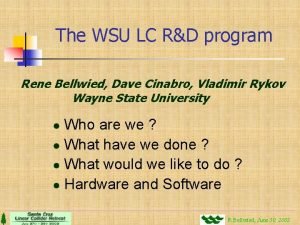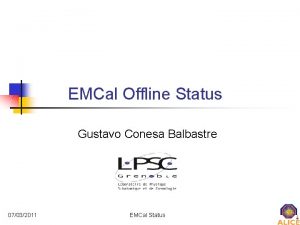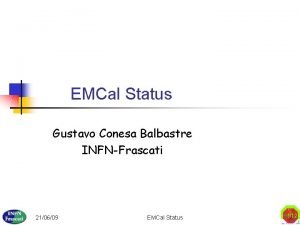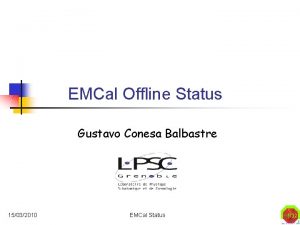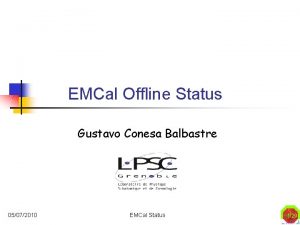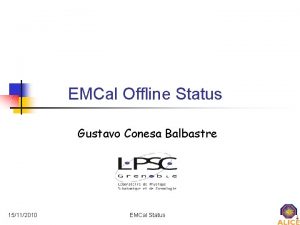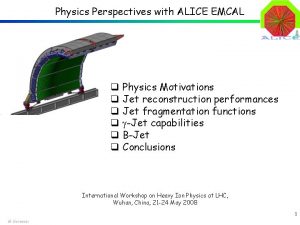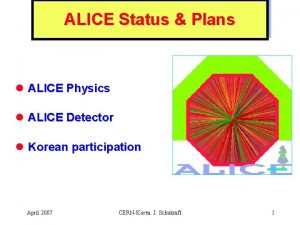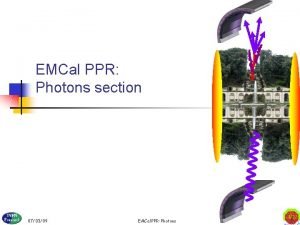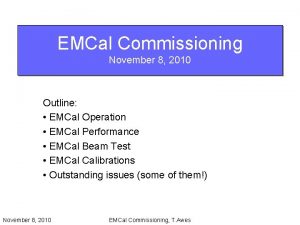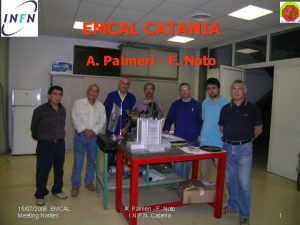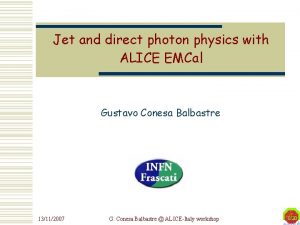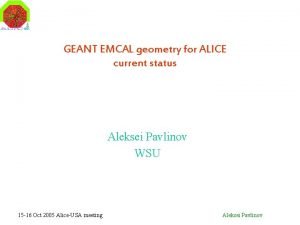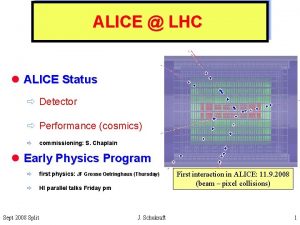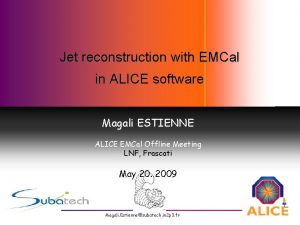The ALICE EMCal Physics Performance Report Status Rene

















- Slides: 17

The ALICE EMCal Physics Performance Report - Status Rene Bellwied (Wayne State University) EMCal Collaboration Meeting, Nantes, July 16 th, 2008

Purpose of the document Ø Originally requested by the Department of Energy and to be completed by Dec. 31 st, 2008, in order to formulate the physics scope of the U. S. contribution to ALICE. Ø Based on discussions with ALICE the EMCal PPR will become an official addendum to the existing ALICE PPR. Ø It will also serve as a reference for the upcoming EMCal Technical Design Report

Organization Ø Ø Report coordinator: Rene Bellwied (Wayne State) Six prioritized sub groups with group coordinators 1. ) jet reconstruction (Joern Putschke) 2. ) EMCal triggering (Mateusz Ploskon) 3. ) photons and gamma jets (Gustavo Conesa Balbastre) 4. ) electron and heavy quark tagging (Mark Heinz / Jennifer Klay) 5. ) particle identified jet measurements (Rene Bellwied) 6. ) jet correlations (Claude Pruneau) Ø Ø Ø Initially groups 1 and 6 will be merged until the jet reconstruction algorithm is optimized. Bi-weekly EVO meetings. Several face-to-face meetings planned around ALICE weeks, ALICE-US collaboration meetings, EMCal meetings Temporary web-page: http: //pdsfweb 01. nersc. gov/~bellwied/emcal-ppr. html Report to PWG-3, PWG-4 and ALICE Physics Board regularly (either the group coordinators or the report coordinator)

Working groups Ø Presently 37 members, almost evenly distributed over the groups, with priority to the first four groups. Ø Contributors from 14 institutions: l Yale, LBNL, Nantes, Wayne State, Grenoble, CERN, Jyvaskyla, ORNL, Tennessee, Creighton, Purdue, UT Austin, LLNL, Frascati

General strategy Ø For jet reconstruction, triggering, photon, and electron (heavy flavor jet) physics improve on the existing simulations as shown in the CD-2 final physics report. Ø For particle identified jet measurements and jet correlations develop a performance report and interface with multiple other detector components in ALICE (TPC, TRD, ITS, PHOS). Use EMCal as tag on same side and measure fragmentation on the away-side

Main goals for group 1: jet reconstruction Attempt to extend the reliability of jet finding algorithm to jet energies below 100 Ge. V. Important for single jets, crucial for jet correlations. Ø Optimize jet finding algorithm through comparison (k. TJet, Jet. An, Fast. Jet) Ø Optimize quenching simulations, estimate effects elliptic and radial flow, hadron corrections, electron conversions, jetenergy correction see Peter Jacob’s talk Ø

Main goals for group 2: jet triggering Attempt to extend the trigger efficiency for jet energies of 50100 Ge. V. Check effect of jet quenching Ø Optimize LVL-1 algorithm by taking altering patch size/geometry based on new mapping manipulations (elelctronics). Ø Optimize HLT through implementation of EMCal software and subsequent merging with TPC, TRD and ITS information. Ø

Main goals for group 3: direct photons and gamma-jets Isolation cut study, Pb. Pb quenched Optimize g/ 0 discrimination for direct photon and g-jet measurement (shower shape, isolation cut studies) Ø g-jet tagging in PHOS and EMCal down to Eg=20 -30 Ge. V in order to extract reliable FF on away side. see Gustavo’s talk Ø

Main goals for group 4: heavy quark tagging with electrons Show electron to heavy meson correspondence in AA collisions. Optimize e/h discrimination Ø Simulate signed DCA method for B-mesons Ø Physics: e, B (J/y+K or e+D) spectra, RAA, B-jets see Mark Heinz’s talk Ø

Main goals for group 5: particle identified jet measurements Correlate high momentum PID measurements (rd. E/dx and V 0 method) to triggered jet rates for single hadron or resonance and dihadron correlation measurements in jets and between di-jets. Ø Determine fragmentation fnunctions for rare hadrons and particle ratios (baryon/meson or particle/antiparticle) in jets in EMCal enhanced data samples and compare to quenching model predictions. Ø

Main goals for group 6: jet correlations di-jet angle di-jet energy correlation di-jet energy balance Simulate possibility of acoplanarity and jet shape measurements based on jet reconstruction resolution. Ø Compare jet axis correlations to leading particle correlations. Ø

Example for Groups 3/5/6: physics on the EMCal triggered away-side High momentum resonances in jets to determine chirality Markert, RB, I. Vitev, ar. Xiv: 0807. 1509) Ø Determine enhancement factors due to jet trigger and analysis improvements due to jet reconstruction Ø (C. Formation time of high p. T resonances Measure modified resonance in away-side jet

Next steps Ø Collect l coming in (see next slides) Ø Collect l simulation requests coming in (see next slides) Ø Obtain l work plans more physics-based Jet MC e. g. JEWEL

Example: work plan group 3 (Gustavo) Task Sub Task Who PID Re-evaluate PID parameters with last Ali. Root version SUBATECH, 1 person Re-study the g/p 0 discrimination SUBATECH, 1 person EMCAL (gamma) - Central barrel (conversion) 1 person combination for Inv, Mass of p 0 (not for PPR? ) Direct photons Isolation cut Gamma-jet Re-evaluate IC with larger amount of events, specially jet-jet, PYTHIA Gustavo Compare predictions for different generators and theory 1 person Decay photon subtraction with Invariant Mass 1 person Improve HI background rejection 1 person Estimate effect of jet-jet contamination 1 person Code implementation in Analysis Frame Gustavo

Example: work plan group 4 (Jennifer) Task Tools Manpower Statistics Revisit rates (higher stats) PYTHIA + Material --kinematics info 0. 5 person 100 k x 15 jet p. T bins PYTHIA/HIJING + Full simulation 0. 5 person Single e, 0 10 k x ~10 p. T ranges 100 k x 15 jet p. T bins + 10 k HIJING bkg Electron and E-Jet trigger PYTHIA/HIJING + Ali. EMCALTrigger, (rates/bkg) HLT Trigger Group? 100 k x 15 jet p. T bins + 10 k HIJING bkg Electron spectra/RAA (e B/D corresp. , compare to TPC and TPC+TRD) PYTHIA + Full simulation 1 person 100 k x 15 jet p. T bins 100 k x ~5 p. Thard bins each of MSEL 4 and MSEL 5 D/B Spectra/RAA (e+D, J/Psi+K, mis-ID) PYTHIA + Full simulation 1 -2 people 100 k x 15 jet p. T bins 100 k x ~5 p. Thard bins each of MSEL 4 and MSEL 5 B-jets (DVM, W, JETAN reco, FF, other tag methods) PYTHIA/HIJING + Full simulation 2 -3 people 100 k x ~5 p. Thard bins each of MSEL 4 and MSEL 5 50 -100 k W-boson decays 10 k HIJING bkg Re-check e-ID matching, p/E) (track-

Example Simulation requests Ø Ø Ideally with Ali. Root and through the GRID Group 2 l l l Ø Group 3 l l Ø 5 -200 Ge. V jet energy spectrum pp and Pb. Pb statistics for each of the bins remains to be determined 10% of planned running year statistic would be comfortable pp exists so mostly Pb. Pb Gamma (EMCAL/PHOS) – jet (quenched, not quenched jet-jet (quenched/not quenched) A couple of quenching scenarios? q= 20 and q=50, models PQM, PYQUEN, maybe JEWEL? Group 4 l see work plan

Summary Ø A dedicated effort to define the physics scope enhancement due to the EMCal in ALICE is underway. Ø We hope to complete the document within six months in close collaboration with the existing PWG’s in ALICE. Ø Any input, comments, suggestions, help is much appreciated.
 Difference between status report and progress report
Difference between status report and progress report Academic status report asu
Academic status report asu Work status report from doctor
Work status report from doctor Kaiser code pink
Kaiser code pink Enter vendor name
Enter vendor name Convercent report status
Convercent report status Seo progress report
Seo progress report Customs broker triennial status report
Customs broker triennial status report Training status report
Training status report Rag status definition
Rag status definition Annual status of education report
Annual status of education report Survey status report
Survey status report 2020 hydropower status report
2020 hydropower status report Status report
Status report Migrao
Migrao Performance status
Performance status Dr shanthi paramothayan
Dr shanthi paramothayan Rene bellwied
Rene bellwied






